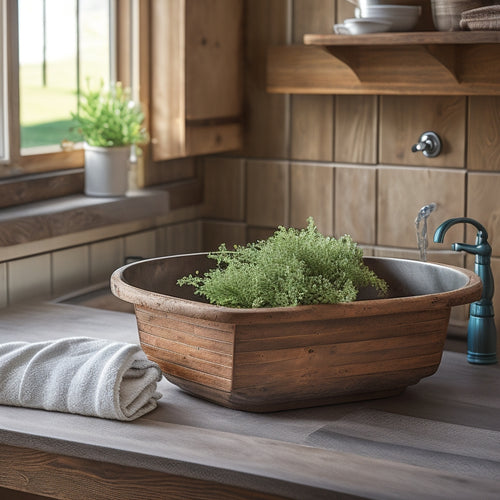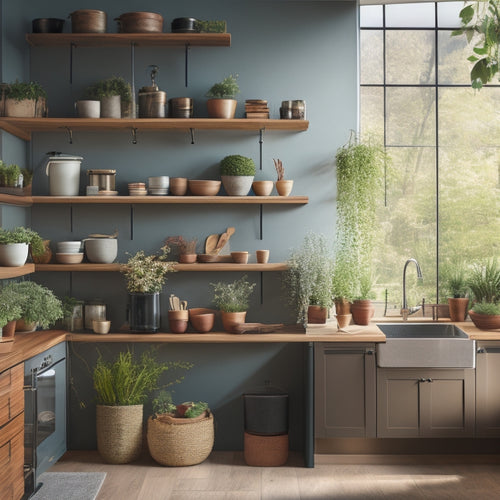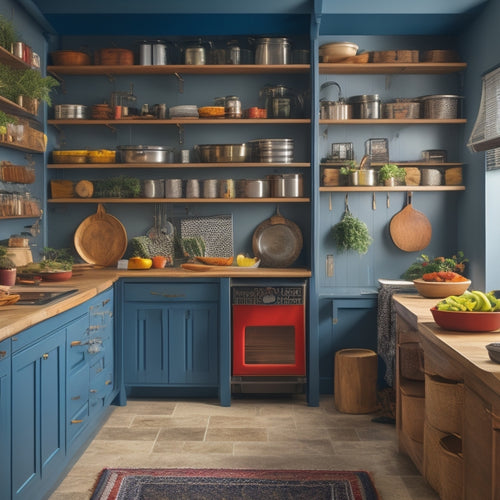
Mastering Kitchen Storage: Expert Strategies Revealed
Share
You're on a mission to master kitchen storage and transform your cooking space into a haven of efficiency. Start by understanding fundamental principles and identifying ideal storage zones that emphasize accessibility. Maximize vertical space, optimize shelves, and declutter countertops to create a clutter-free zone. Assign a landing spot for daily essentials and designate specific areas for different tasks. By applying expert strategies, you'll streamline your workflow, reduce stress, and make cooking a breeze. Now, get ready to dive deeper into the world of customized storage solutions, cabinet organization systems, and essential kitchen zones that will take your kitchen to the next level.
Key Takeaways
• Identify ideal storage zones and designate a place for everything to ensure accessibility and maintain organization.
• Optimize upper cabinets for infrequently used items and utilize wall space with shelves, hooks, or pegboards for maximum storage.
• Implement shelf dividers and categorize items to reduce clutter, improve visibility, and enhance organization.
• Assign a landing strip for daily essentials and maintain an organized pantry and functional drawers to keep the kitchen organized.
• Regularly review and adjust storage systems to prevent clutter buildup and maintain long-term organization.
Kitchen Storage Fundamentals Explained
To create a well-organized kitchen, you must first understand the fundamental principles of kitchen storage, including the ideal storage zones, the significance of accessibility, and the role of vertical storage.
A well-planned kitchen storage system ensures that everything has its designated place, making it easier to find what you need when you need it. This, in turn, reduces clutter, minimizes tripping hazards, and creates a safer cooking environment.
Pantry organization is vital in kitchen storage. Assign a specific zone for your pantry and install shelves, baskets, or bins to store food items, cookbooks, and kitchen gadgets. This will keep your countertops clear and make meal prep more efficient.
Drawer organizers are also necessary for maintaining order in your kitchen. Use dividers or inserts to separate utensils, cookware, and dinnerware, keeping them organized and easy to access.
Maximizing Vertical Space Effectively
As you focus on maximizing your kitchen's vertical space, you'll want to start by optimizing your upper cabinets to store infrequently used items.
Next, you'll need to utilize your wall space wisely by installing shelves, hooks, or a pegboard to hang items like pots, pans, and utensils.
Optimize Upper Cabinets
By strategically arranging items in your upper cabinets, you can reveal the full potential of your kitchen's vertical space, keeping frequently used items within easy reach while storing less-frequently used items towards the top. This approach not only enhances cabinet organization but also optimizes space utilization.
To maximize your upper cabinet space, follow these expert tips:
-
Prioritize frequently used items:
Store your most-used dishes, glasses, and cookware in easy-to-reach locations, usually the middle to lower shelves. -
Group similar items together:
Organize items by category, such as all baking supplies or all cooking utensils, to create a sense of order and make them easier to find. -
Use vertical dividers:
Install shelves, baskets, or dividers to separate items and prevent clutter from building up.
-
Label and sign:
Clearly label each shelf or basket, and consider adding signs to indicate what's stored inside, making it easy to find what you need.
Utilize Wall Space Wisely
Hang your least-used or bulky items, like infrequently used cookbooks or special occasion serving dishes, on wall-mounted shelves or hooks to reclaim valuable counter space and create a sense of openness in your kitchen. This strategic move allows you to free up countertops for more frequently used items, making meal prep and cooking more efficient.
Consider installing floating shelves to create additional storage for items like cookbooks, spices, or oils. These shelves are perfect for displaying decorative items or storing essentials within easy reach.
For a more discreet storage solution, use hidden hooks to hang items like pots, pans, or utensils. This keeps them organized and out of the way, while keeping your kitchen looking sleek and organized.
Don't forget to take advantage of your kitchen's vertical space by installing a magnetic knife rack or pot rack. These space-saving solutions keep your countertops clear and your kitchen tools organized, making cooking and cleaning a breeze.
Install Shelf Dividers
To maximize the vertical space on your shelves, install shelf dividers to separate and categorize your kitchen items, ensuring everything has a designated spot and making it easier to find what you need when you need it. By doing so, you'll create a more organized and efficient kitchen that reduces clutter and saves time.
Here are some benefits of installing shelf dividers:
-
Improved visibility: With dividers, you can see what's stored on each shelf, eliminating the need to dig through clutter to find what you need.
-
Enhanced accessibility: By categorizing your items, you can easily access what you need without having to move everything around.
-
Reduced clutter: Shelf dividers help keep similar items together, preventing clutter from building up and making cleaning easier.
- Better integration with other storage solutions: Shelf dividers can work in tandem with drawer organizers and pantry organization systems to create a seamless storage system.
Decluttering Kitchen Countertops Fast
As you tackle the task of decluttering your kitchen countertops, you'll want to start by identifying the areas that need the most attention.
You'll focus on creating a clutter-free zone, designating a specific spot for items that tend to pile up, and streamlining your daily essentials to make the most of your space.
Clear the Clutter Zone
Within 10 minutes, you can clear the clutter zone on your kitchen countertops by tackling the most visible and distracting items first, such as dirty dishes, expired coupons, and unnecessary appliances. This quick purge will create a sense of organization and make it easier to focus on the remaining items.
Next, sort items into categories like 'keep,' 'donate,' and 'recycle.' Be ruthless – if you haven't used it in the past year, it's probably safe to get rid of it.
Here are some organization hacks to help you clear the clutter zone:
-
Designate a 'junk drawer': Choose a specific drawer or container for items that don't have a designated home, like batteries, twist ties, and other miscellaneous items.
-
Utilize vertical storage: Make the most of your kitchen's vertical space by using wall-mounted shelves, hooks, or a pegboard to hang items like pots, pans, and utensils.
-
Implement a 'one in, one out' policy: Whenever you bring a new item into your kitchen, get rid of an old one to maintain a balanced amount of storage solutions.
- Schedule regular decluttering sessions: Set aside time each week to maintain your newly cleared clutter zone and keep your kitchen countertops organized and safe.
Designate a Landing Spot
Assign a specific spot near the entrance of your kitchen as a 'landing strip' where you can place keys, wallets, and other essentials that tend to clutter your countertops. This designated area will help keep your kitchen organized and prevent clutter from building up.
By having a dedicated spot for daily items, you'll reduce the likelihood of them ending up on your countertops, making meal prep and cooking safer and more efficient.
Consider designating a specific drawer or shelf near the entrance as your landing strip. This will keep your essentials within easy reach while keeping them out of the way. Make sure the area is easily accessible and visible, so you can quickly grab what you need without having to search through cluttered countertops.
As you work on decluttering your kitchen, remember to maintain an organized pantry and functional drawers. This will help you stay on top of clutter and keep your kitchen running smoothly.
Streamline Daily Essentials
To declutter your kitchen countertops quickly, prioritize the items you use daily, such as coffee makers, toasters, and blenders, and determine which ones can be stored out of sight when not in use. This will give you a sense of control over the clutter and allow you to focus on the items that truly need to be on the countertops.
Here are some strategies to help you streamline your daily essentials:
-
Designate a coffee station: Store your coffee maker, coffee beans, and mugs in one convenient spot to reduce clutter and make your morning routine easier.
-
Utilize vertical space: Install a utensil organizer or a spice rack on the wall to free up counter space and keep frequently used items within easy reach.
-
Organize your pantry: Sort and categorize your food and cooking supplies to ensure everything has a designated spot, making it easier to find what you need when you need it.
- Sort utensils by frequency of use: Store your most frequently used utensils in an easy-to-access drawer or container, and reserve less-used items for higher shelves or harder-to-reach storage.
Customized Storage Solutions Uncovered
You can create a tailored storage system that caters to your specific kitchen needs by incorporating customized storage solutions that maximize every available space. By doing so, you'll be able to optimize your kitchen's functionality and safety.
One effective way to achieve this is by installing customized shelving that fits your unique needs. For instance, you can design shelving with adjustable heights to accommodate items of varying sizes, ensuring that everything has a designated place.
When planning your customized storage solutions, consider functional layouts that prioritize ease of access and workflow. This means positioning frequently used items in easy-to-reach locations, while less frequently used items can be stored in harder-to-reach areas.
By doing so, you'll reduce clutter, minimize tripping hazards, and create a more efficient cooking environment. Additionally, consider incorporating features like pull-out drawers, spice racks, and utensil holders to further enhance your kitchen's functionality.
Optimizing Cabinet Organization Systems
With cabinets accounting for the largest storage space in your kitchen, optimizing their organization systems is essential to maintaining a clutter-free and efficient cooking environment. To maximize cabinet storage, you'll want to implement a few strategic solutions.
Here are some expert tips to get you started:
-
Install adjustable shelves to accommodate items of varying sizes and create a customized storage space.
-
Utilize drawer organizers to keep utensils, cookware, and dinnerware organized and easily accessible.
-
Implement pantry organization systems, such as baskets and bins, to store dry goods and keep them out of sight.
- Designate a spice rack near your cooking station to keep frequently used seasonings within reach, and consider under sink storage for infrequently used items.
Essential Kitchen Zones Defined
By dividing your kitchen into functional zones, you can create a more efficient workflow, reduce clutter, and make meal prep a breeze. These zones will help you allocate specific areas for different tasks, making it easier to navigate your kitchen. Typically, a kitchen consists of four to five zones: preparation, cooking, storage, cleaning, and serving.
The preparation zone typically includes your countertops, sink, and refrigerator. This is where you'll prep ingredients, wash veggies, and store frequently used items.
The cooking zone is centered around your stove, oven, and cooktop, where you'll focus on cooking and heating meals.
Effective pantry organization and drawer organization are essential in the storage zone, which includes your cabinets, pantry, and drawers. This is where you'll store dry goods, cookware, and utensils. By designating specific areas for specific items, you'll reduce clutter and make it easier to find what you need when you need it.
Streamlining Kitchen Workflow Secrets
Optimizing your kitchen's workflow requires a thorough analysis of how you move through each zone, identifying bottlenecks, and implementing strategic tweaks to maximize efficiency. You'll want to observe how you navigate between zones, taking note of any areas where you're wasting time or energy.
By streamlining your workflow, you'll be able to cook more efficiently, reduce stress, and create a safer kitchen environment.
To improve your workflow efficiency, consider the following strategies:
-
Designate a 'landing strip': Designate a specific area, like a countertop or tray, as a 'landing strip' for frequently used items, keeping them within easy reach.
-
Implement a 'clean as you go' policy: Clean and put away items as you use them to avoid clutter and reduce cleaning time later.
-
Optimize your utensil storage: Store utensils in a convenient location, organized by frequency of use, to reduce time spent searching for them.
- Create a 'work triangle': Position your sink, stove, and refrigerator in a triangular formation to minimize walking distances and improve space utilization.
Maintaining Organization Long-Term
You've invested time and effort into streamlining your kitchen workflow, and now establishing habits that maintain your newly organized space over the long haul is vital.
To ensure storage maintenance and organizational longevity, create a schedule to regularly review and adjust your kitchen storage systems.
Set aside 15-30 minutes each week to tackle clutter prevention and maintain your sustainable organization.
Start by checking expiration dates and removing any expired or spoiled food items.
Next, wipe down shelves and storage containers to prevent dust and dirt buildup.
Then, assess your storage spaces and make adjustments as needed.
Are there any areas where clutter is starting to accumulate?
Are there any items that need to be relocated or repurposed?
Make a mental note or write down any changes you need to implement.
Frequently Asked Questions
How Do I Organize Kitchen Utensils With Limited Drawer Space?
When dealing with limited drawer space, you'll want to maximize your kitchen's vertical real estate. Invest in vertical organizers to store infrequently used items, and utilize magnetic hooks to hang frequently used utensils, keeping them accessible and safe from clutter.
Can I Use a Pegboard for Hanging Kitchen Accessories?
Did you know 75% of homeowners consider kitchen organization a top priority? You can maximize your kitchen's potential by utilizing vertical space with a pegboard, perfect for hanging pot racks and accessories, keeping them within easy reach while maintaining a clutter-free zone.
Are Kitchen Cart Islands Worth the Investment for Storage?
You're wondering if kitchen cart islands are worth the investment for storage. They can be a great addition, providing extra counter space and pantry organization, while maximizing space in your kitchen, making meal prep safer and more efficient.
What Are Some Creative Ways to Store Snacks and Spices?
You might think you don't have space for snack organization, but think again! Try DIY solutions like repurposing old jars or creating a snack station. For spice storage, utilize hidden hacks like magnetic strips or a spinning spice carousel to keep them within easy reach.
How Can I Repurpose Old Kitchen Items for Storage Purposes?
You'll breathe new life into old kitchen items by upcycling containers into quirky storage vessels and transforming worn-out shelves into DIY shelves, ensuring a safe and functional kitchen space that's uniquely yours.
Related Posts
-

Sink Caddy Organizers for Farmhouse Style Kitchens
Sink caddy organizers are perfect for elevating your farmhouse-style kitchen while keeping it functional. You'll love...
-

Easy-To-Install Kitchen Wall-Mounted Racks
Installing easy-to-use kitchen wall-mounted racks is a smart way to maximize your space. These racks help keep your c...
-

Over-The-Door Kitchen Storage for Large Families
Over-the-door kitchen storage is a transformative solution for large families. It maximizes vertical space, keeping y...


